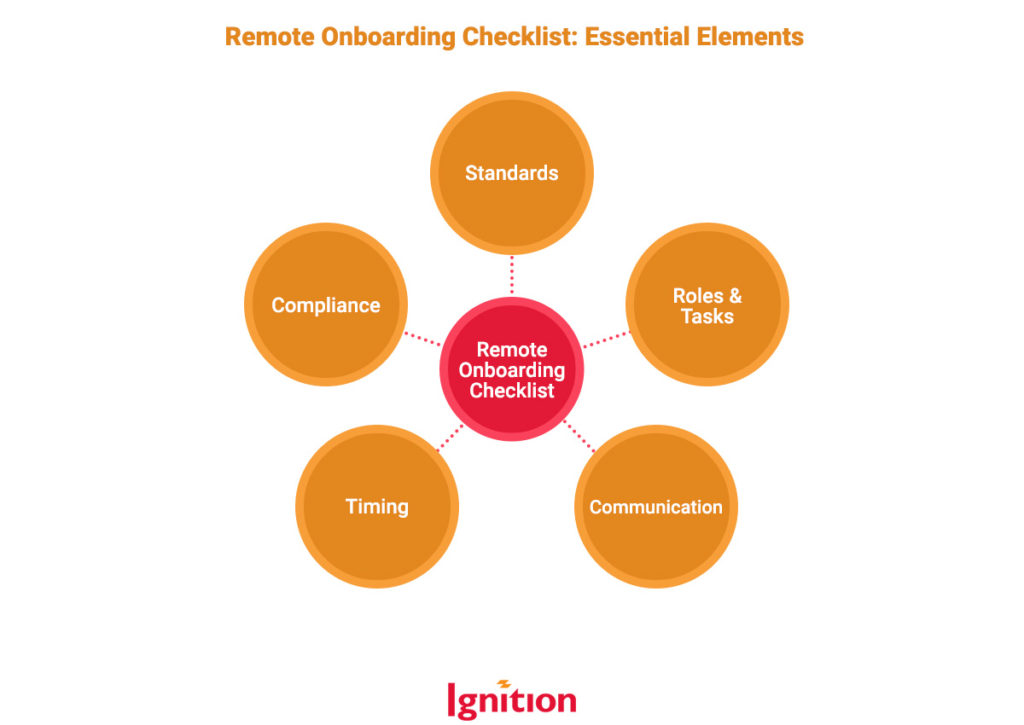First-day foul-ups aren’t good for anyone. They’re not good for your new remote hire, who’s left wondering what kind of dunceville they’ve landed in. They’re not good for business because your new person can’t get quickly integrated with their team and start with what you’re paying them to do. And they’re not good for you because it looks like you couldn’t hit water if you fell off a boat.
Never fear! All you need for a slick and speedy first day is a robust onboarding checklist. We’ll show you how.
Checklist, Schmecklist. Who Needs More Admin?
You do, honey, but it’s not admin. It’s your lifeline. Checklists make everything better, and that includes your reputation. Leave remote onboarding to do its own thing, and you’ll end up with a dumpsterful of gross, including:
- Wasted time, reduced productivity, and a longer learning curve as your hire waits for the resources and tools to get started.
- New hire dissatisfaction if induction guidance is unclear.
- New hire demotivation if they feel isolated or like they’ve got off to a bad start.
- Increased security risks if deployed devices aren’t properly configured, or there’s confusion in your IT team about who’s doing what.
A robust remote onboarding checklist tightens up the onboarding process to replace the dumpsters of gross with a streamlined and effective way of onboarding new hires that keeps everyone happy and productive.
BC: Before The Checklist
Robust checklists aren’t hurriedly scribbled on the back of your forearm during a superquick video call with HR. Before you get all up in the details, decide on the big-picture stuff. Here’s what to consider:

Standards: This helps you create a best-practice onboarding system. You’ll look at the standards you want – things like the speed of onboarding, how you’ll monitor success, and the quality of communication between HR and IT.
Roles & Tasks: Here’s where you decide who in HR and IT does what. This covers overall responsibility and accountability for remote onboarding and day-to-day tasks, such as HR informing IT about new hires or IT people creating new user accounts. It also covers monitoring and review of your onboarding process.
Communication: This sets out the information required for effective onboarding and how it flows: e.g., who’s joining? What’s their role? What IT resources do they need? Where’s the new hire based, and when do you ship their new device? Which device should you ship? How do you confirm that a person has been onboarded properly? How do you know when the different steps of onboarding have been completed?
Timing: Here’s where you consider the timing: e.g., for a start date of the 30th, what needs to happen first, and when? Do you open accounts three days before, a week before, or the start day? Do you have devices ready to go or on order? How should you configure the timing of your welcome and induction emails? How often will you monitor and review?
Compliance: Decide what data security measures will apply to your onboarding procedure. If you’re already SOC 2 or similarly accredited, you’ll already have some cast-iron security protocols in place.
Now You’ve Got All That Down, What Are The Details?
Here goes with the good stuff. Here are the activities you’ll find on a robust remote onboarding checklist:
Remote Onboarding Checklist
| Checklist Tasks | Detail |
| Communicate and confirm new hire details. Do you have all the information you need to enable you to onboard the new hire beautifully? | HR provides IT with new hire details such as their role, seniority and start date. IT will also need further information such as:Which software/cloud accounts – e.g., Salesforce, Dropbox – plus associated access and permission levels are required.Corporate or intranet groups they’ll belong toShipping details for their device.Whether they’ll receive a new or re-assigned device (+ serial number).Which welcome flow they’re assigned to (for customized team-based onboarding) |
| Schedule all onboarding tasks according to your agreed timings and carry them out according to the schedule. | For instance, schedule dates and task reminders for:Creating a new userOpening relevant accounts Ordering and couriering the correct deviceEnsuring you hold the correct software licensesAdding your new hire to the correct groups and induction portalDeploying your welcome email series e.g., schedule first email to your new hire’s home email address at 8 am on their first dayNew user invitationsFirst day actions e.g., zero-touch onboarding |
| Confirm and communicate as each task is complete | Your checklist should be able to show when (and that) an action has been completed, what’s the next step and who’s responsible for it. It should also be able to confirm when a new hire has been successfully onboarded: that they’ve gone through the zero touch or conditional access onboarding methodology and are up and running. Confirm with HR that the new person is fully onboarded. |
| Monitor and complete | The person responsible for monitoring the effectiveness of the onboarding system should monitor outcomes: the checklist can provide space to outline snags, ideas for improvement, etc., for review time. |
Where’s Your Checklist?
Your checklist is a collaborative tool, so it should be online and shareable. You may want to add permission levels to keep the principle of least privilege alive and well, to ensure that people involved in the onboarding process have the access and ability to do stuff as befits their role, but no more.
Proper Remote Onboarding Is Very, Very Detailed, And You’ll Have Forgotten Something
So, this is where we come in. There’s no one-size-fits-all where remote onboarding is concerned, and every checklist is different – even yours. Especially yours. If you’d like to find out more about creating a goof-proof remote onboarding checklist to give your new hires a seamless, shiny first day, give us a call.
Ignition is Silicon Valley’s best (and friendliest) IT security, compliance, and support team. Contact us now – chatting about IT support and cybersecurity is our favorite thing to do!

